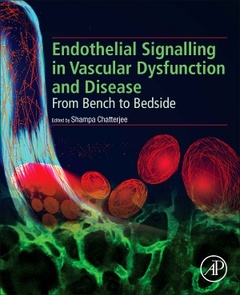Endothelial Signaling in Vascular Dysfunction and Disease From Bench to Bedside
Coordonnateur : Chatterjee Shampa

Endothelial Signaling in Vascular Dysfunction and Disease: From Bench to Bedside provides a detailed understanding of the endothelium, its activation and their link to some common clinical disorders. In addition, the book covers earlier discoveries, including those from the last and 19th centuries. It is split into five sections that cover the vascular tree as an integrative structure, the endothelium in inflammation, endothelial signaling, activation and toxicity with chemotherapy, radiation induced endothelial dysfunction and vascular disease, and therapies in combating vascular diseases. Each section is discussed with a translational approach in order to make the content truly applicable.
This book is a valuable source for basic researchers, clinicians in the fields of Oncology, Cardiovascular Medicine and Radiology, and members of the biomedical field who are conducting studies related to the endothelium and vascular disease.
Part I. The Vascular Tree as an Integrative Structure 1. The Vascular System: Components, Signaling and Regulation2. ROS-induced ROS release in Vascular Signaling and Disease3. Nitric oxide as a vascular modulator to resistance training 4. Reactive Oxygen Species (ROS), Redox signaling and Regulation of Vascular Endothelial Signaling
Part II: The Endothelium in Inflammation: Signaling for Vascular Disease5. Inflammation and Coronary Artery Disease6. An activated endothelium post Organ Transplantation: The Pathogenesis of Rejection7. Neurovascular Unit: Intercellular Signaling and Translational Significance
Part III. Endothelial Signaling, Activation and Toxicity with Chemotherapy 8. Signaling in the Tumor Vasculature 9. Chemotherapy induced Vascular Changes: Onset of Various Pathologies10. Role of Angiogenesis in Wound Healing: Their impact in Acute and Chronic Wound Healing11. Normalization of the Tumor Vasculature 12. VEGF/VEGFR signaling in regulation of innate and adaptive immunity in solid tumors
Part IV: Radiation Induced Endothelial Dysfunction and Vascular Disease13. Human Radiation Exposures (Occupational, Medical, Environmental and Radiation Incidents) and Vascular Dysfunction14. Flow adapted vascular systems: Mimicking the vascular network to predict clinical response to radiation 15. Radiotherapy and its effects on the tumor and normal vasculature 16. Effects of space radiation on the pulmonary endovasculature: implications for future human deep space exploration17. Role of endothelial cells in normal tissue radiation injury
Part V: Therapies in Combating Vascular Diseases18. Experimental Models for Identifying Target Events in Vascular Injury19. Hemeoxygenase and its Metabolites in Regulation of Vascular Endothelial Health20. The endothelium as a target for bacterial infection RBC Conjugated agents in Prophylaxis: Challenges at the Bedside21. Stents versus Scaffolds: Various Tools in Percutaneous Coronary Interventions22. Statins in Deep Vein Thrombosis: Biochemical Approaches to limiting vascular Disease23. Mathematical modeling approaches in understanding endothelial function24. Endothelial dysfunction and vascular diseases. Uric acid and Oxidative stress25. Comparative Assessment of Electrocardiographic Parameters of Some Birds -An Essential Diagnostic Tool in Veterinary practice26. Conclusions, Future perspectives and Shifting paradigms in Endovascular Biology From The Editor’s Desk
basic researchers, clinicians in the fields of Oncology, Cardiovascular Medicine and Radiology, and several members of biomedical field
Currently, Dr. Chatterjee serves on the Editorial Board of several journals in the field of pulmonary physiology (American Journal of Physiology: Lung Cellular and Molecular Physiology, Pulmonary Circulation and Jacobs Journal of Physiology). She has published more than 50 papers in peer reviewed journals. She has also received numerous awards such as the Carolin Tum Suden young Investigator Award, and the Hermann Rahn award for Excellence if Pulmonary Physiology in 2015.
- Discusses the most relevant discoveries in endothelial biology and their link to manifestations of clinical disease
- Presents history and diagrams in each section to highlight the original biological discovery and its link of clinical manifestations of vascular disease
- Includes recent findings on the relationship between endothelial signaling, chemotherapy and radiation induced endothelial dysfunction
Date de parution : 01-2021
Ouvrage de 274 p.
21.4x27.6 cm
Thème d’Endothelial Signaling in Vascular Dysfunction and Disease :
Mots-clés :
?Adaptive immune system; Alloantibodies; Angiogenesis; Angiotensin-converting enzyme 2; Animal model; Antiangiogenic therapy; Antibody-mediated rejection; Antigen-presenting cell (APC); Antioxidant; Aryl hydrocarbon receptor (AHR); Atherosclerosis; Barrier function; Bevacizumab; Biliverdin/bilirubin (BV/BR); Birds; Blood pressure; Bone; Bone morphogenic protein 4 (BMP-4); CAD; Cancer therapy; Carbon monoxide (CO); Cardiovascular disease; Cardiovascular risk; Cellular polarization; Cellular signaling; Chemotherapy; Chemotransduction; Coagulants; Coagulation; Continuous model; Coronary artery disease; Cuff-induced injury; DAMPs; DSA; Delayed radiation effects; Dendritic cells (DCs); Diabetes; Diapedesis; Discrete model; Effector T cells; Electrocardiography; Endothelial; Endothelial cell; Endothelial cells; Endothelial dysfunction; Endothelial progenitor cells (EPCs); Endothelial signaling; Endotheliitis; Endothelium; Extracellular matrix protein; Fibroblast growth factor (FGF); Flow-adapted vascular systems; Gamma-glutamyl transferase; Granulation tissue; Growth factors; HIF-1a; HLA class II; Heart; Heme; Heme oxygenase 1 (HO-1); Hemodynamic flow shear stress; Historical; Human; Hypertension; IL-6; Immune escape; Infection; Inflammation; Innate and adaptive immunity; Interleukin-10 (IL-10); Ionizing radiation; Lymphatic system; Mathematical modeling; Matrix metalloproteases (MMPs); Mechanotransduction; Mesenchymal stem cells (MSCs); Mortality; Myeloid-derived suppressor cells (MDSCs); Neointima; Nitric oxide; Nitric oxide (NO); Normal tissue radiation injury; Normal tissue toxicity; Nuclear factor erythroid 2 (NFE2)-related factor 2 (Nrf2); Osteoblasts; Osteoclasts; Osteocytes; Outcomes; Oxidant stress; Oxidative stress; P wave; PAMPs; PCI; Paracellular diapedesis; Pathologic; Prevention; Procoagulant disease; Pyroptosis; Radiation countermeasures; Radiation damage



